|
The 7X
with emphasis on the Lotus 7X, 7Y, and development of the Lotus Seven Series IV
August 2017: Another period photo of the original build of the 7X...
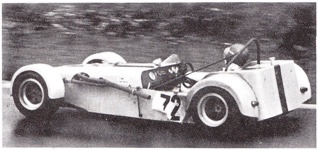
photo: Doug Nye's "The Story of Lotus 1961 to 1971", used with permission, photographer unknown.
This photo shows the decidedly Series 2/3 looking rear end that Lotus apparently permitted to be used on the Series 4 based 7X. The rear lights are P.T. Thorpe as used on post 1965 Series 2 and later standard on Series 3 cars. The rear wings are Series 3, but possibly widened somewhat in this photo from others that are displayed on Anglo Canadian. Obviously, various widths were experimented with.
The information and photos immediately following are from Emlyn Coldicott who lives in the U.K., and who is a relative of the long-time owner of the 7X. The owner - who wishes to remain anonymous - is a dedicated collector of anything Lotus, but shies away from publicity. Not too long ago, Emlyn was able to persuade him that he ought to publicly display some of his collection. Emlyn now assists his relative with displaying the cars and getting them from place to place.
Cheers,
Bill Fayers
September, 2016
For the last 42 years the 7X has been owned (and remained hidden) by a private collector. The interesting thing is that if it was not for him, the 7X would not exist. When it was first advertised for sale ten people were interested, but the other nine all wanted to break up the car for bits. The owner paid more than he wanted for the car, but he paid what the individual parts would have brought. The original Lotus chassis plate - SBC 2647 - is still in the possession of the Foley family and the owner and his relative are attempting to re-unite the plate with the 7X. Negotiations are on-going.
The owner is now starting to let his relative exhibit some of his collection, and on August 20th the car was on show at Malcolm Ricketts Open Workshop. Tim Goss was in attendance, and spent over three hours talking about the car. So far the owner and his relative have shown the Lotus 11 Ghia, Emerson Fittipaldi's Lotus 59, and the 7X. At next January's Autosport Show his Lotus 72 (72/3 - the Dave Charlton car) will be on the Classic Team Lotus stand (it has not been touched since being delivered from South Africa in 1976 and, as a result, is the most original 72 in the world). The private collector prefers to remain anonymous partly due to one of his collection being stolen, the recovery requiring a lot of work on the part of police and the very dedicated relative who did some excellent sleuthing to recover the car for its owner.
Tim Goss, center, holding champagne
four photos below copyright Emlyn Coldicott, 2016)
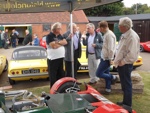

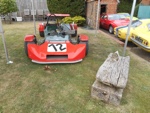

Still with original artwork on the rear wing!
Dennis Ortenburger provided a detailed description of the 7X in his book "Legend of the Lotus Seven" published by Osprey Publishing Ltd, but it did not seem to match up with photos printed in at least three books in my Lotus library. These are: Doug Nye's 'The Story of Lotus 1961- 1971 - Growth of a Legend', 'The Lotus and Caterham Sevens' by Jeremy Coulter, and 'Lotus and Caterham Sevens - Racers for the Road' by John Tipler. In these photographs, the Clubman's Formula 7X was shown as-built by the factory for the commencement of the 1970 racing season (finished on Christmas Day 1969 and driven three days later at Mallory Park by Tim Goss to a first place finish. Goss was the eventual winner of the Shell - Gregor Grant Championship).
Through correspondence with Barry Foley and John Robinson, I discovered that later in the season the cycle fenders were changed to a smaller and more streamlined profile - along with a unique attachment method, and the nose cone was changed for one with a more pronounced downward slope to it. The description of the 7X in Dennis Ortenburger's book was no doubt based on information he received regarding the car with the later modifications. In fact, all the photographs and Mr. Ortenburger's written description showed continual development of the same car over the course of the racing season. The car was eventually purchased from Lotus by Tim Goss, who then sold the car to Barry Foley and Robin Hall in 1972.
Through members of the Clubman's Registry U.K., I was able to contact Barry Foley by telephone in Spring 2002 and had a lengthy and very interesting conversation with him. He was bright and cheerful considering that he had terminal cancer that was to eventually take his life in January 2003. Mr. Foley was the cartoonist who produced 'Catchpole' in Autosport magazine and has a website detailing his and his friend Robin Hall's 'Humbug' Lotus 7 Series 1 Clubman's car - now in the U.S. The following are notes obtained from the conversation.
The original Lotus 7X -- The car in its original build condition before modifications to the body work:
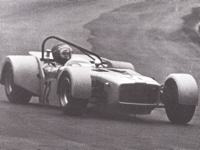
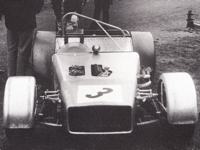
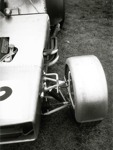
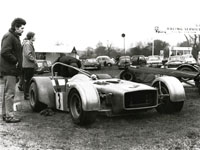
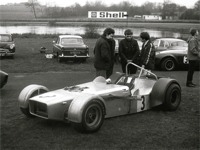
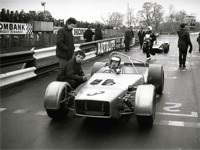
"This is the new Clubmen's Lotus - the 7X - which Tim Goss gave a victorious race debut at Mallory Park last Sunday. Shod with YB11 tyres, the 7X features a sidedraught 1600 Holbay engine, square tube chassis with some F3 components, and independent suspension all round."The above left photo (in a cropped condition) with above script was published in Autosport magazine, January 1st. 1970 edition. The bearded gentleman standing beside the car is identified by the original photographer as Mike Pilbeam, designer of the 7X. In the other photos, Mike Pilbeam is in the company of John Robinson, constructor and mechanic of the 7X, and driver Tim Goss.
photo credit: The above black and white photos of the 7X are courtesy of LAT Photographic, a division of Haymarket Magazines Limited, and may not be reproduced without their permission.
Barry Foley:
The 7X was raced by Tim Goss 1969 - 70. Goss had support of a works mechanic - John Robinson (John built the original 7X for Goss and helped maintain the car. Brother Ken Robinson built the St.Bruno Roughcutter car for Barry (a description of this car is available on the Clubmans Registry web site). Barry and Robin Hall purchased the car from Goss in 1972. It was rebuilt by them three times. It was not a strongly built car. It required much more tubing as it was too weak in its original form. Barry did not think that Mike Pilbeam had much to do with the 7X (writer's note: it is listed on the Pilbeam Company web site as being Mike Pilbeam's design R12). The sheet metal was replaced by tubing (there was originally aluminium and sheet steel at front). The nose was altered as well as the wings (fenders). The car had lasted one season for Goss, but was showing signs of stress to the chassis. The car was actually based on a series IV chassis and had a factory series IV serial number - SBC 2647. It was a promotional Clubman's car. Graham Warner unofficially supported Goss then Barry and Robin, but no official backing from the Lotus Factory was provided. Peter Evans bought the much modified 7X in 1974. It was still racing in Clubmans events in the 1990s after being sold by Evans.
Note: Barry believed (at the time of our conversation, 2002) that the 7X was residing in the U.S., but John Watson of the Historic Lotus Register advised me in 2004 that the 7X was purchased by a rather secretive Lotus collector in 1973 to save it from being broken up. It is certainly a mystery, as the date provided by Barry detailing the purchase of the car by Peter Evans in 1974, does not match up with John Watson's information.
Barry told me that he retained the serial number plate SBC 2647 for sentimental reasons after selling the car. (Barry's son advised me in October 2003, that he had sold the serial number plate after his father's death).
Barry went on to advise that the 7Y (see details elsewhere on this site) was raced by Barry Flegg and was a Lotus 7, Series 3, with an engine modified by Broadspeed. Barry Flegg raced the 7Y in the under 1000c.c. class. In Barry's words, "it was a tongue-in-cheek dig at the 7X" It had double front wishbone suspension, and twin trailing arms. The engine was equipped with twin down-draught Weber carbs that protruded through a hole in the top of the bonnet and surrounded by a formed cowl.
Barry concluded with his thoughts on suspension ideas for the 7 and advised that a Mumford may work on a Series 3 but with only 1/2" of travel allowed, whereas a Lotus 7 rear axle moves 4" - 6". (The 'Mumford' is a series of rear suspension developments invented by Michael Mumford for Mallock Racing. It is a superior and brilliant form of Watts linkage used for racing cars with solid rear axles).
Barry closed by providing the contact information of John Robinson, who still holds the record for the fastest assembly of a Lotus 7. John was a mechanic for the Lotus Formula 1 team, and personal mechanic to Mario Andretti on the Vels Parnelli Formula 1 team.
John Robinson:
I contacted John by post and then through a series of e-mails during 2002. As I have continually found with all the people I have spoken to who are in some way involved with cars, especially racing cars, the help and information they have provided is priceless, freely and gladly given by them, and very much appreciated by me. John took the time to send a very informative e-mail on the Series 3 and 4 production and the development of the 7X. I have permission to reproduce the pertinent details that follow:
"I got married in July 1966 and moved in October of the same year to Hethel in Norfolk, where after a year in Components, transferred to the Service department. After about a year there I was approached to transfer again to the Development Department to build the Series 4 Lotus Seven, which I did. After 2 years in the Development Department building the Series 4, I went on to the production line set up in the main factory to build the Series 4. While working on the production line, Tim Goss came to the factory to request a Series 4 to be made into a racing car for him to race in the Clubmans' Series which at the time were mostly Series 2 and Series 3 Lotus 7s. A group of the lads working on the production line were also involved in the building of the Lotus 7X for him. Most of the time we worked after working hours and on weekends. I enjoyed building the 7X so much that when we were nearing completion of the car, I offered to look after the car for Tim Goss in my spare time and take the car to the circuits for him. We went on to win the championship for that year but will say more about that later.
Tim eventually sold the car to Barry Foley and Robin Hall and although I did not have the car at home, I continued with the maintenance of the vehicle travelling from Norfolk to London most weekends to set up the car and go to meetings with Barry and Robin. Although we won races, the competition had caught up with the engines and chassis (engine 140 b.h.p Holbay Ford 1600 c.c. - Barry Foley had the original specs. from Holbay). We certainly made some radical changes to the 7X during the time I spent with Barry and Robin (who shared the driving honours).
I had been racing with Barry and Robin during the Goldleaf days of Formula 1 and they were about to change over to JPS, and very much to my surprise one day when working on the line building the Series 4 was called over to Peter Warr's office (who was the manager of Team Lotus), and was offered a position in the new Formula 3 team. After a year working with the F3 team, Lotus stopped racing F3 and I went on to build and work on the F2 team for a year. At the end of that year F2 stopped for Lotus and I went on to work on the F1 team working with Emerson Fittipaldi, Ronnie Peterson, Jackie Ickx and Mario Andretti. We won 3 world titles during the time I was there in the F1 team. I left Lotus and went to Parnelli Jones' F1 with Mario Andretti, but that lasted just over a year. I then left motor racing completely in 1977. I do very occasionally get to races with Barry and his son.
The 7X Car was a Series 4 chassis with modification to the front suspension to change to rose-joint adjustable bearings from the rubber joints on the road car. Special hubs were made for the front wheels, and on the very first attempt, the front cycle type wheel covers (fenders) were mounted with a complicated mounting system that supported the wing stays on both sides of the wheel (similar to older motorcycle or bicycle mudguards). This looked good but was very impractical as when wheel changes were required this whole assembly had to be removed as well, so I modified this after a couple of races. The rear suspension was made into independent using the Lotus Elan differential assembly with Lotus 61 Formula Ford rear suspension hubs (uprights), with adjustable radius arms and links. The bodywork on the original 7X was constructed out of aluminium and followed the Series 4 shape - this was required by the factory. Note: the rear end of the 7X looked more like the rear end of a Series 3 but with the boot/gas tank area slightly raised. When racing, the water temperature would not get up to any sort of acceptable level so with consultation with David, we modified the front and altered the radiator position and the nose cone which allowed much better air flow and raised the water temperature.
The 7X when racing with Tim in that first year was the start of my racing career. We had minor problems with the car and modifications were made as required. Although I used to take the car back home after the races, the factory never had anything to do with any modification after we modified the nose cone due to temperature problems. Barry and Robin carried out all the real modifications in their garage at Woodford in London.
May 2002
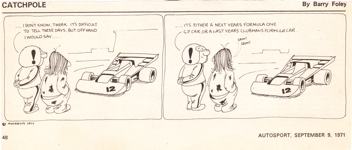 John Robinson subsequently sent me some photographs and articles regarding the 7X. The photographs showed modifications to the exterior of the car while still being driven by Tim Goss, with much more pronounced modifications under the ownership of Barry Foley and Robin Hall. The 7X under the latters' ownership came to look much more like the later built St. Bruno Roughcutter car, and was almost unrecognizable from its original form. John also included a "Catchpole" cartoon from 1971 drawn by Barry Foley. In the cartoon, there is a character referred to as "Tweak". This was Barry Foley's affectionate name for his good friend and mechanic, John Robinson.
Below is the 7X as modified by Barry Foley. The rear frame of the car has been removed, and spoilers have been added to the car. The car was purchased by Barry Foley from Tim Goss in 1972, and raced by him and Robin Hall in Clubmen's events.
John Robinson subsequently sent me some photographs and articles regarding the 7X. The photographs showed modifications to the exterior of the car while still being driven by Tim Goss, with much more pronounced modifications under the ownership of Barry Foley and Robin Hall. The 7X under the latters' ownership came to look much more like the later built St. Bruno Roughcutter car, and was almost unrecognizable from its original form. John also included a "Catchpole" cartoon from 1971 drawn by Barry Foley. In the cartoon, there is a character referred to as "Tweak". This was Barry Foley's affectionate name for his good friend and mechanic, John Robinson.
Below is the 7X as modified by Barry Foley. The rear frame of the car has been removed, and spoilers have been added to the car. The car was purchased by Barry Foley from Tim Goss in 1972, and raced by him and Robin Hall in Clubmen's events.
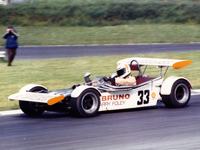
 John wrote:
Brother Ken and myself had some very exciting times together working with Barry and Robin in the early days of the 7X. Ken lived at that time just around the corner from the garage and I lived in Norfolk and as a result, travelled from Norfolk to London most weekends to work on the car. Barry had lots of ideas for the car and as the photos have shown we did quite a lot of modifications to the car. The car's basic chassis was always the original Lotus 7X from the factory, and then there were the frame and brackets welded on to the chassis to affix different nose cones and rear wings as required. Some worked, some did not last past testing, or the race."
Photographic Reference:
Page 253 of Doug Nye's book "The Story of Lotus - 1961-1971 Growth of a Legend" published by Motor Racing Publications Ltd, provides a left side view of the 7X with Tim Goss driving. The shape of the lower chassis member, just behind the front left wing and to the side of the engine compartment, is decidedly Series 4 in shape as the frame tubes on the series 4 chassis curve slightly upwards in the same place as the 7X. The rear of the 7X (from just behind the driver's seat to the rear of the car) looks more like a grafted on Series 3 rear end with a slight rise to the upper rear tubing. The petrol tank and filler are exposed (i.e. no cover on the rear of the chassis), and the rear wings are fitted with Thorpe brake/taillights (as fitted to post 1965 Series 3 Sevens). The angular shape of the chassis to the side of the driver is again Series 4 in nature. Both front and rear wings are described as 'wrap-round' with the fronts forming an arc of over 180 degrees, and the rears slightly less than that. The rear wings are very much Lotus Seven Series 3 in shape.
Page 183 of John Tipler's book "Lotus and Caterham Seven - Racers for the Road", published by The Crowood Press Ltd, shows a photograph of the 7X in one of its early guises. The rear wings look narrower than later modifications, and the front wings look to scribe a circle of over 180 degrees. The nose cowl is very rectangular and 'boxy' in appearance similar to the Series 4.
Page 119 of Jeremy Coulter's book "The Lotus and Caterham Sevens - A Collector's Guide" published by Motor Racing Publications Ltd, shows a photograph of Tim Goss racing the 7X, along with a technical description of the car. Mr. Coulter writes that the 7X was a Martin Wade/Mike Pilbeam collaboration. He notes that the chassis bore similarities to the S4 Seven. In this photograph, the rear wings are very wide, with the tops parallel to the ground looking very much like widened Series 3 rear wings. The front wings are still wraparound forming a semi-circle of over 180 degrees. The top of the petrol tank area behind the driver seems to have gained a full flat cover over the rear of the car.
Mike Pilbeam Racing
I contacted Mike Pilbeam in 2003, and he was very helpful and willing to assist me in my inquiries. He acknowledged that he had listed the 7X as his design R12 on his site, but could not recall too many details of the car. He remembered John Robinson, and noted that John was probably the very best bet to provide details of this race car. He offered to search his files at home for drawings of the car and get back to me. In a subsequent phone call he advised that he could not locate anything on the car, but would advise me if he ever found anything of relevance.
7X in the paddock at Brands Hatch
John wrote:
Brother Ken and myself had some very exciting times together working with Barry and Robin in the early days of the 7X. Ken lived at that time just around the corner from the garage and I lived in Norfolk and as a result, travelled from Norfolk to London most weekends to work on the car. Barry had lots of ideas for the car and as the photos have shown we did quite a lot of modifications to the car. The car's basic chassis was always the original Lotus 7X from the factory, and then there were the frame and brackets welded on to the chassis to affix different nose cones and rear wings as required. Some worked, some did not last past testing, or the race."
Photographic Reference:
Page 253 of Doug Nye's book "The Story of Lotus - 1961-1971 Growth of a Legend" published by Motor Racing Publications Ltd, provides a left side view of the 7X with Tim Goss driving. The shape of the lower chassis member, just behind the front left wing and to the side of the engine compartment, is decidedly Series 4 in shape as the frame tubes on the series 4 chassis curve slightly upwards in the same place as the 7X. The rear of the 7X (from just behind the driver's seat to the rear of the car) looks more like a grafted on Series 3 rear end with a slight rise to the upper rear tubing. The petrol tank and filler are exposed (i.e. no cover on the rear of the chassis), and the rear wings are fitted with Thorpe brake/taillights (as fitted to post 1965 Series 3 Sevens). The angular shape of the chassis to the side of the driver is again Series 4 in nature. Both front and rear wings are described as 'wrap-round' with the fronts forming an arc of over 180 degrees, and the rears slightly less than that. The rear wings are very much Lotus Seven Series 3 in shape.
Page 183 of John Tipler's book "Lotus and Caterham Seven - Racers for the Road", published by The Crowood Press Ltd, shows a photograph of the 7X in one of its early guises. The rear wings look narrower than later modifications, and the front wings look to scribe a circle of over 180 degrees. The nose cowl is very rectangular and 'boxy' in appearance similar to the Series 4.
Page 119 of Jeremy Coulter's book "The Lotus and Caterham Sevens - A Collector's Guide" published by Motor Racing Publications Ltd, shows a photograph of Tim Goss racing the 7X, along with a technical description of the car. Mr. Coulter writes that the 7X was a Martin Wade/Mike Pilbeam collaboration. He notes that the chassis bore similarities to the S4 Seven. In this photograph, the rear wings are very wide, with the tops parallel to the ground looking very much like widened Series 3 rear wings. The front wings are still wraparound forming a semi-circle of over 180 degrees. The top of the petrol tank area behind the driver seems to have gained a full flat cover over the rear of the car.
Mike Pilbeam Racing
I contacted Mike Pilbeam in 2003, and he was very helpful and willing to assist me in my inquiries. He acknowledged that he had listed the 7X as his design R12 on his site, but could not recall too many details of the car. He remembered John Robinson, and noted that John was probably the very best bet to provide details of this race car. He offered to search his files at home for drawings of the car and get back to me. In a subsequent phone call he advised that he could not locate anything on the car, but would advise me if he ever found anything of relevance.
7X in the paddock at Brands Hatch
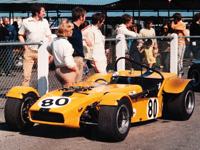 At right is a photograph, courtesy of John Robinson, showing Tim Goss in the paddock at Brands Hatch prior to a race. The car is showing some modification to the bodywork since its original build completion on Christmas Day 1969, and first race at Mallory Park on the following Sunday. Alterations to the nose cone (rivet detail evident) provide a more noticeable slope from the original box like shape. The original front and rear wheel cycle wings of over 180 degrees radius (widened Series 3 wings on the rear of the original) have been replaced.The front wings are held in place by a controversial method whereby the wing is braced with tubing that bolts onto the front stub axles on the inside and outside. John Robinson advised that although this method stabilized the wing, it made it extremely difficult to change the front wheels quickly in the event of an emergency.
7X Goss and Robinson
Left: Tim Goss in the driver's seat of the 7X waiting for the 'off' at Brands Hatch. Ken Robinson (constructor/mechanic of the Barry Foley/Robin Hall St. Bruno Roughcutter car) is holding on to the roll bar, John Robinson is next to him, with an unknown gentleman making a point!
Middle: John Robinson waiting for his turn in the 7X at an unknown track location.
Right: Testing the 7X, location unknown (possibly the Lotus test track?) At right is a photograph, courtesy of John Robinson, showing Tim Goss in the paddock at Brands Hatch prior to a race. The car is showing some modification to the bodywork since its original build completion on Christmas Day 1969, and first race at Mallory Park on the following Sunday. Alterations to the nose cone (rivet detail evident) provide a more noticeable slope from the original box like shape. The original front and rear wheel cycle wings of over 180 degrees radius (widened Series 3 wings on the rear of the original) have been replaced.The front wings are held in place by a controversial method whereby the wing is braced with tubing that bolts onto the front stub axles on the inside and outside. John Robinson advised that although this method stabilized the wing, it made it extremely difficult to change the front wheels quickly in the event of an emergency.
7X Goss and Robinson
Left: Tim Goss in the driver's seat of the 7X waiting for the 'off' at Brands Hatch. Ken Robinson (constructor/mechanic of the Barry Foley/Robin Hall St. Bruno Roughcutter car) is holding on to the roll bar, John Robinson is next to him, with an unknown gentleman making a point!
Middle: John Robinson waiting for his turn in the 7X at an unknown track location.
Right: Testing the 7X, location unknown (possibly the Lotus test track?)
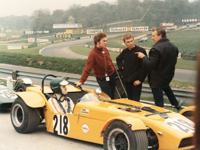
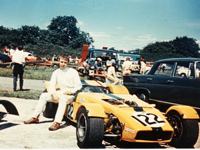
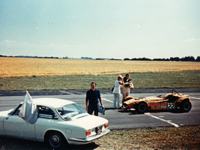 Both John and his brother Ken maintained the 7X for Barry and his driving partner Robin Hall. Occasionally John would get a turn at the wheel. Incidentally, John still holds the record for the fastest assembly time of a Lotus 7 kit from scratch.
A last word from Barry Flegg
Regarding the 7X. I don't know if I have told you the story behind the X / Y, but after winning the 1 litre Lotus 7 championship in 69/70 and Tim Goss winning the 1500 1 litre in '70, we were both invited by Colin Chapman to the Lotus factory to be told they were to build 2 cars for the Gregor Grant Clubmen's Championship. What eventually happened was only 1 car was produced, and Tim got the drive. Don't know if he had a private arrangement with Lotus, but that's how the 7Y was born as a 'tongue-in-cheek' dig at Lotus and Colin Chapman! Incidentally, I believe Lotus did this to a number of other drivers i.e. Tim Schenken etc. I did lead the 7X on two occasions, once putting the 7Y alongside the 7X at Brands Hatch on 'Ford Sport Day', a big occasion in those days, but I never beat it!
(RETURN TO THE ANGLO-CANADIAN CORNER MAIN PAGE)
Both John and his brother Ken maintained the 7X for Barry and his driving partner Robin Hall. Occasionally John would get a turn at the wheel. Incidentally, John still holds the record for the fastest assembly time of a Lotus 7 kit from scratch.
A last word from Barry Flegg
Regarding the 7X. I don't know if I have told you the story behind the X / Y, but after winning the 1 litre Lotus 7 championship in 69/70 and Tim Goss winning the 1500 1 litre in '70, we were both invited by Colin Chapman to the Lotus factory to be told they were to build 2 cars for the Gregor Grant Clubmen's Championship. What eventually happened was only 1 car was produced, and Tim got the drive. Don't know if he had a private arrangement with Lotus, but that's how the 7Y was born as a 'tongue-in-cheek' dig at Lotus and Colin Chapman! Incidentally, I believe Lotus did this to a number of other drivers i.e. Tim Schenken etc. I did lead the 7X on two occasions, once putting the 7Y alongside the 7X at Brands Hatch on 'Ford Sport Day', a big occasion in those days, but I never beat it!
(RETURN TO THE ANGLO-CANADIAN CORNER MAIN PAGE)
|